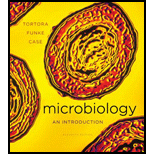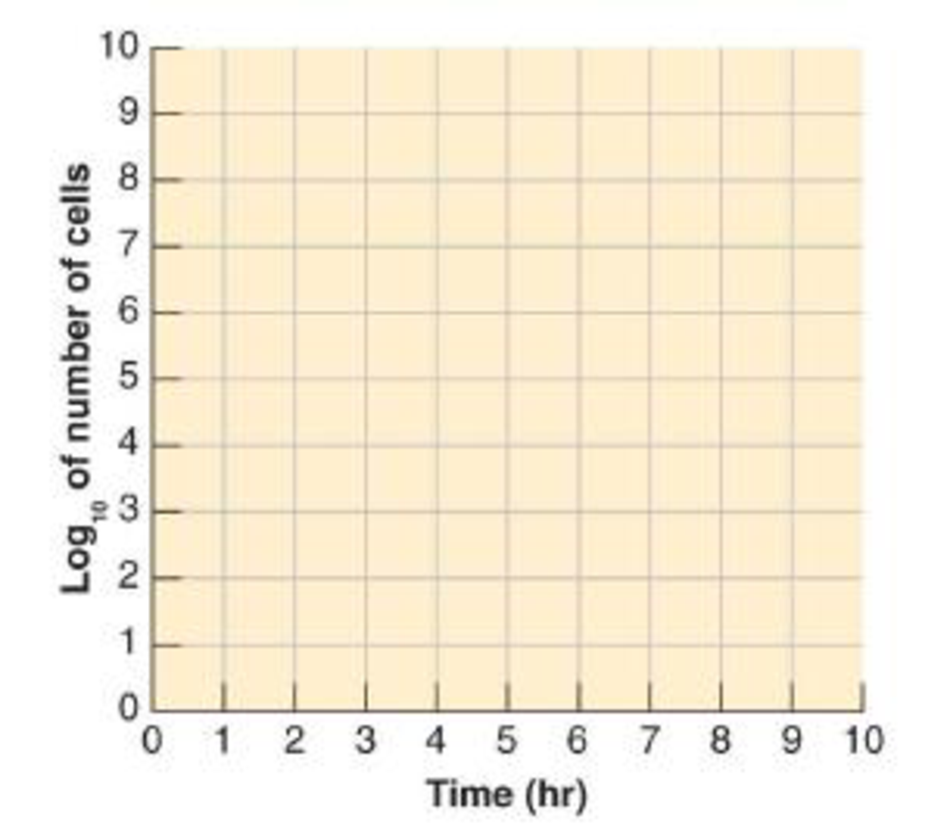
Microbiology: An Introduction
11th Edition
ISBN: 9780321733603
Author: Gerard J. Tortora, Berdell R. Funke, Christine L. Case
Publisher: Benjamin Cummings
expand_more
expand_more
format_list_bulleted
Textbook Question
Chapter 6, Problem 9R
DRAW IT Draw the following growth curves for E. coli, starting with 100 cells with a generation time of 30 minutes at 35°C, 60 minutes at 20°C, and 3 hours at 5°C.
- a. The cells are incubated for 5 hours at 35°C.
- b. After 5 hours, the temperature is changed to 20°C for 2 hours.
- c. After 5 hours at 35°C, the temperature is changed to 5°C for 2 hours followed by 35°C for 5 hours.

Expert Solution & Answer
Want to see the full answer?
Check out a sample textbook solution
Students have asked these similar questions
E.coli was incubated with aeration in a nutrient medium containing two carbon sources provided one at a time, and the following growth curve was made from this culture.
a. Explain what happened at the time marked x.
b. Which substrate provided “better” growth conditions for the bacteria? How can you tell?
Draw the following growth curves for E. coli, starting with 100 cells with a generation time of 30 minutes at 35°C 60 minutes at 20°C, and 3 hours at 5°C. The cells are incubated for 5 hours at 35°C
You inoculate two test tubes with the same amount of identical growth medium and with the same number of
identical yeast cells and grow these cells under identical conditions except for the presence or absence of
oxygen.
a) After 12 hours, all of the glucose in each culture has been consumed. You determine the number of total cells
found in each culture and find that one culture has more cells than the other.
Which culture would have the greater cell density, the one grown aerobically or the one grown
anaerobically?
Explain why the culture you chose above can make more cells with the same amount of glucose than the
other culture.
Chapter 6 Solutions
Microbiology: An Introduction
Ch. 6 - Prob. 1RCh. 6 - Prob. 2RCh. 6 - Prob. 3RCh. 6 - Seven methods of measuring microbial growth were...Ch. 6 - By deep-freezing, bacteria can be stored without...Ch. 6 - A pastry chef accidentally inoculated a cream pie...Ch. 6 - Nitrogen and phosphorus added to beaches following...Ch. 6 - Differentiate complex and chemically defined...Ch. 6 - DRAW IT Draw the following growth curves for E....Ch. 6 - NAME IT A prokaryotic cell hitched a ride to Earth...
Ch. 6 - Two culture media were inoculated with four...Ch. 6 - Two culture media were inoculated with four...Ch. 6 - Use the following graph to answer questions 3 and...Ch. 6 - Use the following graph to answer questions 3 and...Ch. 6 - Assume you inoculated 100 facultatively anaerobic...Ch. 6 - The term trace elements refers to a. the elements...Ch. 6 - Which one of the following temperatures would most...Ch. 6 - Which of the following is not a characteristic of...Ch. 6 - Which of the following types of media would not be...Ch. 6 - An organism that has peroxidase and superoxide...Ch. 6 - E. coli was incubated with aeration in a nutrient...Ch. 6 - Clostridium and Streptococcus are both...Ch. 6 - Most laboratory media contain a fermentable...Ch. 6 - Flask A contains yeast cells in glucose-minimal...Ch. 6 - Clinical Applications and Evaluation 1. Assume...Ch. 6 - Heat lamps are commonly used to maintain foods at...Ch. 6 - The number of bacteria in saliva samples was...
Additional Science Textbook Solutions
Find more solutions based on key concepts
Consider the experiment described in Section 2.1 in which Ted Garland and colleagues bred mice to run long dist...
Evolutionary Analysis (5th Edition)
A student moving out of a dormitory crouches in correct fashion to lift a heavy box of books. What prime movers...
HUMAN ANATOMY
What are the cervical and lumbar enlargements?
Principles of Anatomy and Physiology
Knowledge Booster
Learn more about
Need a deep-dive on the concept behind this application? Look no further. Learn more about this topic, biology and related others by exploring similar questions and additional content below.Similar questions
- Suppose that you were tasked with 4 cultures of a specific Bacteria Species in Luria Broth medium: (1) culture A – cells are in lag phase; (2) culture B – cell in log phase; (3) culture C – cells in stationary phase; and culture D – cells in decline phase. Imagine that you observe the growth rates of each culture in a fresh sterilized LB medium. Now, plot the outcome growth curves of cultures A, B, C and D in a single graph.arrow_forwardConsider the growth curve shown below. Cells were grown in a medium containing 1 % w/v glucose and 0.5% w/v acetate. Calculate the generation time when growing on glucose and also when growing on acetate. Pay particular attention to the split time axis with different time scales. Glucose generation time = hrs Acetate generation time = hrs 1011 1010 109 108 107 106 105 104 10 15 20 25 30 time (hours) HA log of numbers of bacteria LOarrow_forwardThe graph represents the growth rates of different types of bacteria labeled w-z at different temperatures. -10 0 10 20 30 40 50 60 70 80 90 100 110 Temperature (°C) Lactic acid bacteria are type x. They are used in the preparation of fermented food products. What will be the impact on the lactic acid bacteria when the temperature is increased to 60°C? O These bacteria will become type y. O These bacteria will work more effectively. O These bacteria will work at the same speed. O These bacteria will stop fermenting food. Growth Rate of Bacteriaarrow_forward
- Based on the growth curve, which ONE of the following best describes what would happen if sample of culture in the presence of drug B is inoculated onto drug-free growth medium? Select one: A. Growth present, but cell count increased by at least 99.9% of the original culture B. No growth after 24 hrs C. Growth at 24 hrs D. Not possible to predict because the culture could either be alive or dead E. Growth present, but cell count reduced by at least 99.9% of the original culturearrow_forwardIf the generation time of Escherichia coli is 30 minutes, starting with 4 E. coli cells, how many cells can you obtain after 2 hours of growth? A: cellsarrow_forwardIn an experiment to calculate the decimal reduction time for an Escherichia coli culture, viable cells were exposed to a constant temperature of 80°C for a set amount of time. After exposure, the remaining number of surviving cells were counted. Based on Table 1, what is the decimal reduction time?Table 1. Decimal Reduction Time for E. coli Heated to 80°C Total time of exposure (minutes): Number of Microbial Cells Present: 0 100 1 80 3 50 4 42 6.5 26 13 10 21 0arrow_forward
- A bacterial culture contains 500 cells/mL in the exponential growth phase at 8 AM. If you consider a generation time 20 minutes, what will be the total number of cells/mL after three hours (i.e. at 11 AM)?arrow_forward4. (a) Which of the following chemical reactions is an overall oxidation-reduction (redox) reaction that involves oxidation number changes in their reactions? A. NaOH + H₂O → Na¹ + H3O+ + OH B. HCl + H₂O → H3O+ + Cl- C. CO₂ + H₂O → H+ + CO3²- D. N₂ + 3H₂ → 2NH3arrow_forwardDraw a semi-logarithmic diagram showing the killing kinetics of a vegetative bacterial culture, assuming appropriate temperature, e.g. 100°C. Label the axes. 1.) What are the kinetics for killing bacterial spores at 100°C and 121°C 2.) and what about a mixture of different heat-resistant vegetative cells?arrow_forward
- Define growth. Why does the lag phase in some bacteria is short or absent and the log phase of the bacterial growth is preferred in any industrial process?arrow_forwardDifferentiate the growth curve exhibited by the same inoculum under the following conditions. Draw and label the parts of your growth curve. A). If it is exponentially growing and inoculated in the same nutritious medium under the same optimum conditions. B). If it is taken from an old culture and inoculated into the same nutritious medium and incubated under the same optimum conditions in (A). C). If it is taken from an old culture and inoculated to a different and less nutritious medium and incubated under the same optimum conditions as (A).arrow_forwardAfter inoculating and incubating an agar slant from a pure broth culture of a bacterial species such as E. coli, which of the following would indicate an unsuccessful aseptic transfer? (Choose ALL that apply) a - There is fungal growth in the original broth culture tube. b- There is too much growth on the agar slant. c- There are colonies of similar morphology on the slant. d - There are red, yellow, and white colonies on the slant. e - There is no growth on the slant.arrow_forward
arrow_back_ios
SEE MORE QUESTIONS
arrow_forward_ios
Recommended textbooks for you
 Human Anatomy & Physiology (11th Edition)BiologyISBN:9780134580999Author:Elaine N. Marieb, Katja N. HoehnPublisher:PEARSON
Human Anatomy & Physiology (11th Edition)BiologyISBN:9780134580999Author:Elaine N. Marieb, Katja N. HoehnPublisher:PEARSON Biology 2eBiologyISBN:9781947172517Author:Matthew Douglas, Jung Choi, Mary Ann ClarkPublisher:OpenStax
Biology 2eBiologyISBN:9781947172517Author:Matthew Douglas, Jung Choi, Mary Ann ClarkPublisher:OpenStax Anatomy & PhysiologyBiologyISBN:9781259398629Author:McKinley, Michael P., O'loughlin, Valerie Dean, Bidle, Theresa StouterPublisher:Mcgraw Hill Education,
Anatomy & PhysiologyBiologyISBN:9781259398629Author:McKinley, Michael P., O'loughlin, Valerie Dean, Bidle, Theresa StouterPublisher:Mcgraw Hill Education, Molecular Biology of the Cell (Sixth Edition)BiologyISBN:9780815344322Author:Bruce Alberts, Alexander D. Johnson, Julian Lewis, David Morgan, Martin Raff, Keith Roberts, Peter WalterPublisher:W. W. Norton & Company
Molecular Biology of the Cell (Sixth Edition)BiologyISBN:9780815344322Author:Bruce Alberts, Alexander D. Johnson, Julian Lewis, David Morgan, Martin Raff, Keith Roberts, Peter WalterPublisher:W. W. Norton & Company Laboratory Manual For Human Anatomy & PhysiologyBiologyISBN:9781260159363Author:Martin, Terry R., Prentice-craver, CynthiaPublisher:McGraw-Hill Publishing Co.
Laboratory Manual For Human Anatomy & PhysiologyBiologyISBN:9781260159363Author:Martin, Terry R., Prentice-craver, CynthiaPublisher:McGraw-Hill Publishing Co. Inquiry Into Life (16th Edition)BiologyISBN:9781260231700Author:Sylvia S. Mader, Michael WindelspechtPublisher:McGraw Hill Education
Inquiry Into Life (16th Edition)BiologyISBN:9781260231700Author:Sylvia S. Mader, Michael WindelspechtPublisher:McGraw Hill Education

Human Anatomy & Physiology (11th Edition)
Biology
ISBN:9780134580999
Author:Elaine N. Marieb, Katja N. Hoehn
Publisher:PEARSON

Biology 2e
Biology
ISBN:9781947172517
Author:Matthew Douglas, Jung Choi, Mary Ann Clark
Publisher:OpenStax

Anatomy & Physiology
Biology
ISBN:9781259398629
Author:McKinley, Michael P., O'loughlin, Valerie Dean, Bidle, Theresa Stouter
Publisher:Mcgraw Hill Education,

Molecular Biology of the Cell (Sixth Edition)
Biology
ISBN:9780815344322
Author:Bruce Alberts, Alexander D. Johnson, Julian Lewis, David Morgan, Martin Raff, Keith Roberts, Peter Walter
Publisher:W. W. Norton & Company

Laboratory Manual For Human Anatomy & Physiology
Biology
ISBN:9781260159363
Author:Martin, Terry R., Prentice-craver, Cynthia
Publisher:McGraw-Hill Publishing Co.

Inquiry Into Life (16th Edition)
Biology
ISBN:9781260231700
Author:Sylvia S. Mader, Michael Windelspecht
Publisher:McGraw Hill Education
Haematology - Red Blood Cell Life Cycle; Author: Armando Hasudungan;https://www.youtube.com/watch?v=cATQFej6oAc;License: Standard youtube license